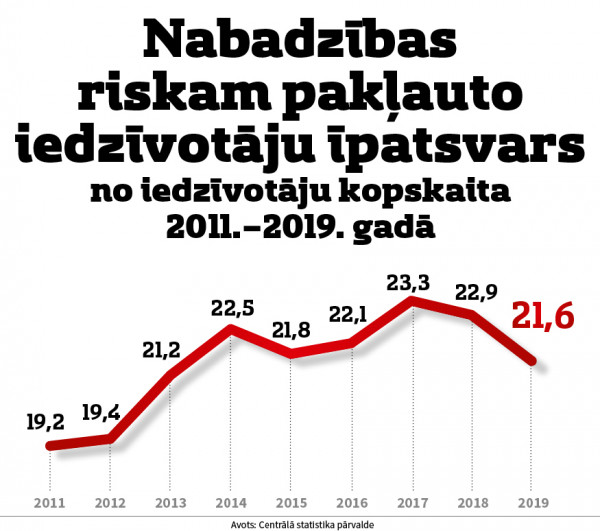Families with children are increasingly at risk of poverty
At least a fifth of Latvia's population is at risk of poverty, and although the proportion of poor people in the country's total population is declining, it is unfortunately very slow.
Compared to previous years, the risk of poverty has increased for families with children. The risk of poverty increased particularly rapidly in families with one adult and children.
Almost half a million at risk of poverty

The Central Statistical Bureau has published the latest data on the number of people at risk of poverty. Experts explain that the at-risk-of-poverty index is the proportion of the population (measured as a percentage) whose disposable income is below the at-risk-of-poverty threshold. In 2019, 407,000 or 21.6 percent of the population in Latvia was at risk of poverty, which is 1.3 percentage points less than in 2018. The disposable income of this population was below the at-risk-of-poverty threshold. The at-risk-of-poverty threshold in 2019 was 5,296 euros per year or 441 euros per month in a one-person household but in a household of two adults and two minors - 11,122 euros per year or 926.83 euros per month.
The data show that the lowest number of people at risk of poverty since 2011 was in 2012 - 387,000, but the highest was in 2017 - 446,000. The highest number of people at risk of poverty as a percentage of the population was also the highest in 2017. Since then, the proportion of people at risk of poverty has been declining - in 2018, it was almost 23 percent of the Latvian population, but in 2019 - 21.6 percent.
The at-risk-of-poverty threshold exceeds the minimum wage
223 euros per month in 2011, 441 euros last year - this is the at-risk-of-poverty threshold in a one-person household. For a household with two adults and two children under the age of 14, the at-risk-of-poverty threshold is calculated differently - in 2019, it was 927 euros.
The highest share of the population at risk of poverty was in Latgale (35.9 percent) and the lowest - in Riga (15.9 percent) and Pieriga (16.1 percent). In Kurzeme, 27.9 percent of the population was at risk of poverty, in Vidzeme - 25.3 percent and in Zemgale - 20.7 percent.
The risk of poverty has increased for families with children
Compared to previous years, the risk of poverty has increased for families with children, and poverty affects both families with one adult and families with two adult caretakers. The risk of poverty increased particularly rapidly among families with one adult and children, reaching 30.6 percent last year (an increase of 4.4 percentage points since 2018).
At-risk-of-poverty rates increased both for families with two adults and two children (from 11.1 percent in 2018 to 12.8 percent in 2019) and for families with two adults and three or more children (from 16.7 percentage points in 2018 to 17.7 percentage points in 2019). Last year, the risk of poverty also increased for children under the age of 17 - from 14.5 percent in 2018 to 15.8 percent in 2019.
Single seniors over the age of 65 were still most at risk of poverty. In 2019, there were 71.7 percent of such pensioners. The second largest group at risk of poverty was single people under the age of 64. In 2019, the working population was the least at risk of poverty, but the unemployed and pensioners were significantly more at risk of poverty (51.7 and 46.5 percent, respectively).
Is the poverty rate affected by gender?
Poverty rates also vary by gender. Under the age of 17, men are more at risk of poverty, while in adulthood (and at all ages), women are more at risk of poverty. If this difference is not so great in the working years, then women are significantly more at risk of poverty among pensioners. For example, one in five men and one in three women over the age of 65 are at risk of poverty. There is an even bigger difference over the age of 75 - among men it is still a fifth of men, but the proportion of poor women has increased up to 40 percent.
Without benefits, about 40 percent would be at risk of poverty
Specialists have concluded that in 2019, the support provided by social transfers (social benefits) reduced the share of the population at risk of poverty by 16.8 percentage points, as the impact of social benefits or scholarships on the income of the population has slightly increased in recent years. Without the social benefits, at least 38 percent of the population would be at risk of poverty.
The Central Statistical Bureau publication “Poverty and Social Exclusion in Latvia” will be published in January 2021.
